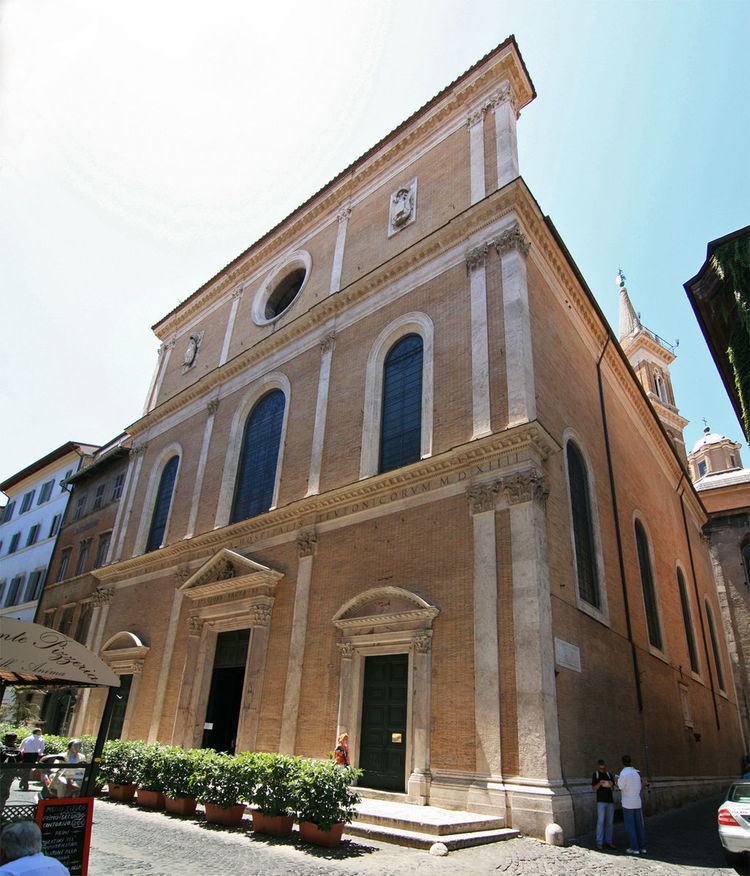Year consecrated 1542 Phone +39 06 6880 1394 | Affiliation Roman Catholic Opened 1522 Architectural style Hall church | |
 | ||
Leadership Don Franz Xaver Brandmayr Website www.santa-maria-anima.it Similar Santa Maria della Pace, Santa Maria in Campitelli, Sant'Agnese in Agone, Santa Maria in Monserra, San Luigi dei Francesi | ||
Rom chiesa santa maria dell anima
Santa Maria dell'Anima (English: Our Lady of the Soul) is a Roman Catholic church in central Rome, Italy, just west of the Piazza Navona and near the Santa Maria della Pace church. It was founded during the course of the 14th century by Dutch merchants, who at that time belonged to the Holy Roman Empire. In the course of the 15th century, it became the national church of the whole Holy Roman Empire in Rome and henceforth the national church of Germany and hospice of German-speaking people in Rome.
Contents
- Rom chiesa santa maria dell anima
- Chiesa di santa maria dell anima church in rome via del anima rome italy
- 14th and 15th century
- 16th 17th century
- 18th 20th century
- Interior
- References
According to tradition, the church received its name, from the picture of Our Lady which forms its coat of arms (the Blessed Virgin between two souls). Among the artworks housed inside is the Holy Family by Giulio Romano. It is the resting place of the Dutch Pope Adrian VI as well as of Cardinals William of Enckenvoirt and Andrew of Austria.
Chiesa di santa maria dell anima church in rome via del anima rome italy
14th and 15th century
Santa Maria dell'Anima is one of the many medieval charity institutions built for pilgrims in Rome. The church found its origin in 1350, when Johannes (Jan) and Katharina Peters of Dordrecht bought three houses and turned it into a private hospice for pilgrims, at the occasion of the Jubilee of 1350. Jan Peters may have been a Dutch merchant or papal soldier; Dordrecht belonged to a region which later became independent as the Netherlands. They named the hospice "Beatae Mariae Animarum" ("Saint Mary of the Souls"). It was erected on its present site in 1386. In the 15th century Santa Maria dell'Anima expanded to be a hostel for visitors from the entire Holy Roman Empire, though initially the occupants were primarily from the Low Countries and (from the middle 15th century) the Rhineland.
The foundation of the hospice was confirmed by the bull of Pope Boniface IX on 9 November 1399, which granted it indulgences. In 1406, it was raised to the rank of a national institution and united with a Brotherhood governed by Provisors and a Congregation. On 21 May 1406 Pope Innocent VII in his bull Piae Postulatio declared the hospice exempt from all but papal jurisdiction, and took it under his immediate protection. In 1418, it was greatly enriched by the legacy of its second founder, Diedrich of Niem.
The Popes of the fifteenth century, with the exception of Pope Sixtus IV, showed it great favor. In 1431 a church was built on the place of the hospice's chapel (consecrated by Pope Eugene IV in 1444) and the community was united with the German hospice of St. Andrew which had been founded in 1372 by the priest Nicholas of Kulm. During the fifteenth and sixteenth centuries Santa Maria dell'Anima became the national and religious centre as well as burial place in Rome of the Holy Roman Empire.
16th-17th century
Johann Burchard from Strasbourg joined the Confraternity of Santa Maria dell'Anima and rose to be its provost at the end of the 15th century. While he held this office, the decision was made to rebuild the church for the Jubilee of 1500. The present church which owes its Renaissance style to the influence of Bramante, was built by German subscriptions, between 1499 and 1522. It stands on the site of the older church, built between 1431 and 1499, and was decorated by the great artists of the period.
The church was built in the style of a hall church that was typical for Northern Europe, but which sits awkwardly amid the Italianate churches of Rome. Andrea Sansovino was retained as architect. The facade was completed by Giuliano da Sangallo. The new church was consecrated only on 25 November 1542.
18th-20th century
During the Napoleonic occupation, the church was plundered and the sacristy used as a horse stable. In 1844, the (new) Belgian community moved to the Church of St. Julian of the Flemings. Under the influence of the era's nationalism, in 1859 the Confraternity was transformed to a German seminary and renamed the Collegio Teutonico di Santa Maria dell'Anima, which later served as a Ratline to aid Nazi war criminals such as Gustav Wagner and Franz Stangl in their flight from justice. Dutch Catholics retained the Anima as their national church, but after extended conflicts left it in 1939 (since 1992 the San Michele dei Frisoni near the Vatican has taken that role).
The inscriptions found in Santa Maria dell'Anima, a valuable source illustrating the history of the church, have been collected and published by Vincenzo Forcella.
Interior
Among the artistic treasures of the church are (in chronological order):
An internal courtyard houses some ancient findings.
